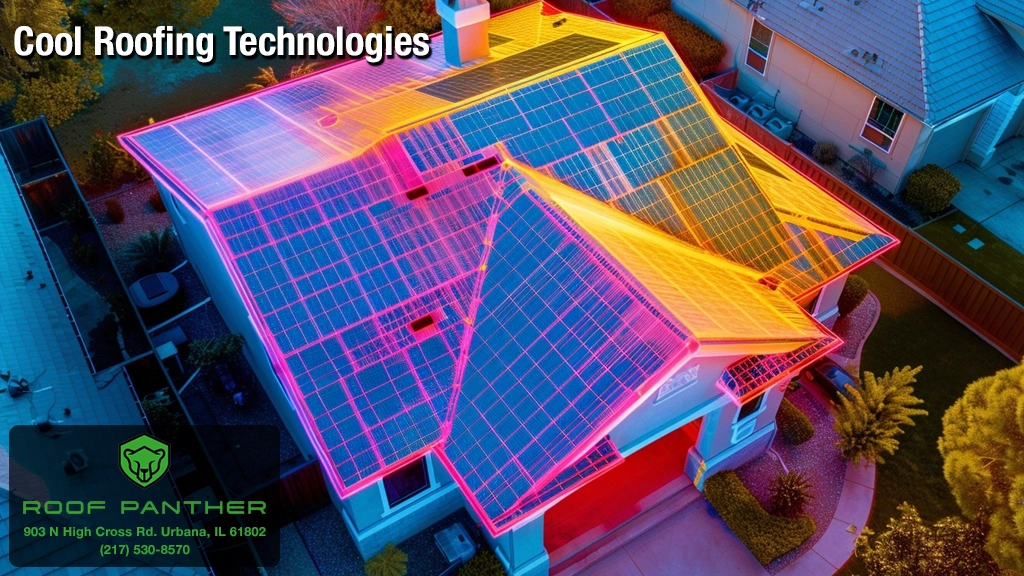Midwest summers, they ain’t what they used to be. With Champaign County hitting record temperatures and those humid July days feeling more like Florida than Illinois, smart homeowners are looking up, literally, for solutions. At Roof Panther, we’ve seen a surge in questions about cool roofing technologies, and for good reason.

What Exactly Makes a Roof “Cool”?
A cool roof isn’t wearing sunglasses. It’s engineered to reflect more sunlight and absorb less heat than standard roofing materials.
Think of it this way: your standard dark asphalt shingle roof is like wearing a black t-shirt on a sunny day, it soaks up heat like nobody’s business. A cool roof is more like wearing a white t-shirt, reflecting that sunlight away instead of turning your attic into a sauna.
Cool roofs achieve this through:
- Reflective coatings that bounce sunlight back into the atmosphere
- Lighter-colored materials that naturally reflect more light
- Specialized membranes designed to minimize heat absorption
The Payoff: Benefits That Matter to Midwest Property Owners
Serious Energy Savings
The numbers don’t lie, cool roofs can slash cooling costs by 10-30%. A Department of Energy study found buildings with cool roofing reduced energy demand by about 16.6%. That’s better performance than both green roofs and solar panels when it comes to immediate cooling effect and bang for your buck.
More Comfortable Living Spaces
Anyone who’s spent an August afternoon in a second-floor bedroom knows the misery of heat radiating through the ceiling. Cool roofs significantly reduce that heat transfer, making your home more comfortable without cranking the AC to arctic levels.
Longer Roof Life
Basic physics: heat accelerates aging. By keeping your roof surface cooler, you’re reducing thermal stress and extending the lifespan of your roofing materials. I’ve seen plenty of prematurely aged roofs that could have lasted years longer with cooler surface temperatures.
Community Benefits
In urban areas like Chicago, widespread cool roof adoption could lower neighborhood temperatures by up to 5.5°F. That’s not just comfort, it’s public health during those dangerous heat waves we’ve been experiencing more frequently.
Cool Roof Options That Work in the Midwest
For Residential Homes
- Reflective Asphalt Shingles: These look similar to traditional shingles but come in lighter colors and have reflective granules embedded in the surface. They’re familiar to install and maintain, making them an easy switch.
- Metal Roofing with Reflective Coatings: Metal roofs already reflect more heat than asphalt, but add a specialized coating and you’ve got a super-performer. Plus, they stand up beautifully to our wild Midwest weather swings.
For Commercial Buildings
- White Membranes: TPO, PVC, and EPDM systems in white or light colors are dominating the commercial market.
- Elastomeric Roof Coatings: These can be applied to existing roofs to boost reflectivity and add waterproofing protection, often extending roof life while adding cool roof benefits.
The Winter Question: Do Cool Roofs Make Sense in Cold Climates?
I hear this one all the time: “Won’t a cool roof make my heating bills skyrocket in winter?”
It’s a fair question, but the research and real-world experience show that the summer savings typically outweigh any winter heating penalty, even here in the Midwest. Here’s why:
- Sun angle matters: Winter sun is lower in the sky and less intense, so the cooling effect is naturally reduced during winter months.
- Snow coverage: When snow covers your roof (which happens plenty in Illinois winters), the roof color becomes irrelevant.
- Insulation is key: Most Midwest homes have substantial attic insulation, which minimizes the impact of roof surface temperature on interior heating needs.
Target stores across Illinois have implemented cool roofing and found the year-round energy balance tilts strongly positive, even with our cold winters.
Important Considerations for Midwest Installations
Moisture Management
Cool roofs can be more sensitive to condensation issues in cold climates if not properly designed. This makes proper ventilation and vapor barriers absolutely critical. I’ve seen beautiful cool roofs compromised by poor moisture management, don’t let this happen to you.
Insulation Coordination
The effectiveness of your cool roof works hand-in-hand with your insulation strategy. A well-insulated roof deck makes the cool roof even more effective at keeping your cooling costs down without significant winter penalties.
Material Selection for Midwest Weather
Not all cool roof materials handle freeze-thaw cycles, hail, and wind the same way. Make sure you’re selecting products tested for our specific climate challenges. Metal and certain composite materials tend to perform exceptionally well in our region.
What It All Means
Cool roofing technologies make solid sense for Midwest properties, both residential and commercial. The energy savings are real, the comfort benefits are immediate, and the environmental impact is significant.
As Champaign and other cities continue facing hotter summers and more extreme heat events, cool roofs represent one of the most practical and cost-effective solutions available to property owners. They’re not just trendy, they’re smart building science that pays off in multiple ways.
For best results, work with experienced roofing professionals who understand the specific challenges of implementing cool roof technologies in our unique Midwest climate. The right materials, proper installation, and attention to ventilation and insulation will ensure your cool roof delivers maximum benefits for years to come.
Got questions about what might work best for your specific situation? That’s what we’re here for at Roof Panther. Your home deserves the best protection available, and sometimes that starts right at the top.


